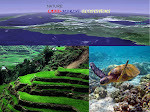Publikasi Pada Jurnal Internasional (Slovakia)
Biologia 64/2: 1—4, 2009
Section Botany
DOI: 10.2478/s11756-009-0074-y
Spatial-based assessment of land use, soil erosion, and water
protection in the Jeneberang valley, Indonesia
Sumbangan Baja 1, Muhamad Ramli 2 & Syamsul A. Lias 1
1Department of Soil Science Hasanuddin University Makassar, Republic of Indonesia; email: sbja02@yahoo.com.au
2Soil Research Station Maros, Department of Agriculture, Republic of Indonesia
Abstract:
Soil erosion by water is considered as one of the most significant forms of land degradation that affects sustained productivity of agricultural land use and water quality. It is influenced by a considerable number of factors (including climate,
soil, topography, land use and types of land management), so that the information on the spatial distribution of soil erosion rate and its related effects can be effectively employed as a baseline data for land use development and water protection.
The principal aim of this study is three-fold: (i) to map existing land use; (ii) to assess and map the spatial distribution of average annual rate of soil losses in the study area; (iii) to evaluate spatial matching between existing and proposed land use
including a distance analysis from the water body (the Bili-Bili Dam). An analytical procedures used, respectively, include supervised classification of satellite imagery, application of RUSLE (Revised USLE), and overlay analysis in a raster GIS environment, utilising available information in the region covering some parts of Jeneberang catchment, South Sulawesi,
Indonesia. The results suggest that the outputs of this study can be used for the identification of land units on a cell-basis with different land use types, rate of soil loss, inconsistency between proposed and planned land use, as well as the threat of land degradation to the main river and the dam. The analytical procedures developed in this research may be useful in
other areas, particularly in the studies related to the assessment and mapping of land use and erosion for the importance of sustainable land use at a relatively large area.
Key words: Jeneberang catchment; land use; soil erosion; GIS; RUSLE; spatial analysis
Jumat, 19 Juni 2009
Publikasi 2009: Konsep "Asesmen Sumberdaya Lahan"
CAB Reviews: Perspectives in Agriculture, Veterinary Science, Nutrition and Natural Resources 2009 4, No. 015 (London)
Review
Land use choice and land resource assessment in agriculture
Sumbangan Baja*
Address: Department of Soil Science Hasanuddin University, Makassar, South Sulawesi 90245, Indonesia. *Correspondence: Email: sbja02@yahoo.com.au
Received: 22 July 2008
Accepted: 13 February 2009
doi: 10.1079/PAVSNNR20094015
The electronic version of this article is the definitive one. It is located here: http://www.cababstractsplus.org/cabreviews
gCAB International 2009 (Online ISSN 1749-8848)
Abstract
Land degradation is continuing to occur in many different environmental conditions. This is
because land use choice in a particular area always goes beyond the capability and suitability of that area for such type of land use. Traditionally, land use choice depends very much on the criteria used, but in essence it should embrace three different and sometimes conflicting aspects: productivity, workability and the environment. The decision criteria derived from environmental attributes that represent degradation potential will become important determinants for sustained use of the land. As land qualities vary in space and change over time, land use is a dynamic entity which is subject to human intervention, socio-economic conditions and changing land use policy, and land is usually subject to degradation, effective land resource assessment is crucial for decision-making to arrive at an optimal land use choice. The primary aim of this review is to discuss some important aspects related to a fundamental concept of land use choices with the perspective of resources and the environment in agriculture. A case study is also presented that implements some analytical tools in decision-making procedures of land use allocation, following a proposed scheme in land resource assessment. The proposed scheme and the case study presented here reveal that much effort should be put in making use of land attribute information (criteria) and analytical tools that can provide an aid in support of optimal spatial decision-making in future land use placements.
Keywords: Land use, Land suitability evaluation, GIS, Environment, Decision-making, Land use planning
Review
Land use choice and land resource assessment in agriculture
Sumbangan Baja*
Address: Department of Soil Science Hasanuddin University, Makassar, South Sulawesi 90245, Indonesia. *Correspondence: Email: sbja02@yahoo.com.au
Received: 22 July 2008
Accepted: 13 February 2009
doi: 10.1079/PAVSNNR20094015
The electronic version of this article is the definitive one. It is located here: http://www.cababstractsplus.org/cabreviews
gCAB International 2009 (Online ISSN 1749-8848)
Abstract
Land degradation is continuing to occur in many different environmental conditions. This is
because land use choice in a particular area always goes beyond the capability and suitability of that area for such type of land use. Traditionally, land use choice depends very much on the criteria used, but in essence it should embrace three different and sometimes conflicting aspects: productivity, workability and the environment. The decision criteria derived from environmental attributes that represent degradation potential will become important determinants for sustained use of the land. As land qualities vary in space and change over time, land use is a dynamic entity which is subject to human intervention, socio-economic conditions and changing land use policy, and land is usually subject to degradation, effective land resource assessment is crucial for decision-making to arrive at an optimal land use choice. The primary aim of this review is to discuss some important aspects related to a fundamental concept of land use choices with the perspective of resources and the environment in agriculture. A case study is also presented that implements some analytical tools in decision-making procedures of land use allocation, following a proposed scheme in land resource assessment. The proposed scheme and the case study presented here reveal that much effort should be put in making use of land attribute information (criteria) and analytical tools that can provide an aid in support of optimal spatial decision-making in future land use placements.
Keywords: Land use, Land suitability evaluation, GIS, Environment, Decision-making, Land use planning
Langganan:
Postingan (Atom)

